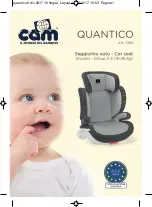
45
• Inspect the seat regularly, paying particular attention to the attachment points, seams and
adjusting devices. Make sure that all mechanical parts are fully functional. Never grease or oil
any part of the child seat. Stop using the seat if parts are damaged or loose.
• In the event of an emergency, it is important to release the seat belts quickly. T
his means
that the 5-point harness release button is not fully secured, ensure that your child does not
play with the 5-point harness buckle.
• Set a good example for your child and always wear a seat belt. An adult who is not wearing
a seat belt can also pose a risk to a child.
• Before every car journey, make sure that the seat is correctly positioned.
• The seat must also be secured when not in use. An unsecured child seat can cause injury
to passengers even in emergency braking.
• Always ensure that th
e car seat does not become jammed on any surface when closing
the vehicle door or adjusting the rear seat.
• For some vehicle seats made of delicate materials, using the car seat can leave marks
or cause discolouration. To prevent this, you can place a blanket, towel or similar product
under the car seat.
4.0 In-vehicle installation
In the event of sudden braking or an accident, persons not wearing seat belts may cause injury
to other passengers.
Always check that:
• The seatbacks in the vehicle are
locked (i.e. the rear seat folding backrest lock is engaged).
• All heavy objects and those with sharp edges are secured (e.g. on the rear shelf).
• All passengers have fastened their seat belts.
• The seat is always secured, even if the child is not being
carried in it.
4.1 Rearward-facing installation for children from 40 to 105 cm (0 to approx. 4) using the
ISOFIX attachment system with a support leg.
IMPORTANT! The location of the ISOFIX attachment points and other necessary information
for installing the seat in the vehicle is given in the vehicle handbook. The user MUST also read
the manual from the vehicle.
• Before positioning the seat in the car, we recommend unfolding the support leg (9) (fig. A.2).
• The cover (19) on the ISOFIX attachments (16) (
if not already removed) must be removed
from the seat, for this purpose push the ISOFIX release button (15), and the system will release
the cover, which must be removed (fig. A.3a, A.3b).
•
Place the seat without the cover (19) with the folded-out support leg on the vehicle seat.
•
Attach the ISOFIX guides (18) to the car seat connectors (A.4).
• Slide the ISOFIX attachments (16) to their maximum length by unlocking and holding the
sliding lever (12) (fig. A.5a) and then sliding the attachments (fig. A.5b). This has to be done
on both sides of the seat.
• Connect the extended ISOFIX attachments (16) to the ISOFIX guides (18) installed in the car
seat until a characteristic click occurs (figure A.6). After the correct installation of the ISOFIX
Summary of Contents for I-GUARD
Page 2: ......
Page 5: ...5 A 1 ...
Page 6: ...6 A 2 A 3a A 3b A 4 ...
Page 7: ...7 A 5a A 5b A 6 A 7a A 7b ...
Page 8: ...8 A 8 A 9 A 10a A 10b ...
Page 9: ...9 A 11 A 12 A 13 ...
Page 10: ...10 B 1 B 2a B 2b B 3 B 4 ...
Page 11: ...11 C 1 C 2 B 5 B 6 ...
Page 12: ...12 C 3 C 4 C 5 ...
Page 187: ......
Page 188: ...WWW KINDERKRAFT COM ...
















































